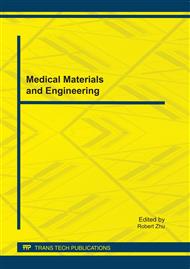[1]
M.K. Bhan, B. Rajiv, B. Shinjini, Typhoid and paratyphoid fever, Lancet. 366(2005)749-762.
DOI: 10.1016/s0140-6736(05)67181-4
Google Scholar
[2]
K. Molbak, Human health consequences of antimicrobial drug-resistant Salmonella and other foodborne pathogens, Clin. Infect. Dis. 41(2005)1613-1620.
DOI: 10.1086/497599
Google Scholar
[3]
T.A.H Le, L. Fabre, P. Roumagnac,Clonal expansion and microevolution of quinolone-resistant Salmonella enterica serotype typhi in Vietnam from 1996 to 2004. J. Clin. Microbiol. 45(2007) 3485-3492.
DOI: 10.1128/jcm.00948-07
Google Scholar
[4]
T. Kadhiravan, N. Wig, N, Kapil, Clinical outcomes in typhoid fever: adverse impact of infection with nalidixic acid-resistant Salmonella typhi. BMC Infect. Dis. 5(2005)37.
DOI: 10.1186/1471-2334-5-37
Google Scholar
[5]
J.A. Crup, K. Kretsinger, K. Gay, Clinical response and outcome of infection with Salmonella enterica serotype typhi with decreased susceptibility to fluoroquinolones: a United States FoodNet multicenter retrospective cohort study. Antimicrob.Agents.Chemother. 52(2008)1278-1284.
DOI: 10.1128/aac.01509-07
Google Scholar
[6]
T. Dimitrov, E.E. Udo, O. Albaksami, Ciprofloxacin treatment failure in a case of typhoid fever caused by Salmonella enterica serotype Paratyphi A with reduced susceptibility to ciprofloxacin. J. Med. Microbiol. 56(2007)277-279.
DOI: 10.1099/jmm.0.46773-0
Google Scholar
[7]
D.S. Chandel, R.Chaudhry, B. Dhawan, Drug-resistant Salmonella enterica serotype Paratyphi A in India. Emerg. Infect. Dis. 6(2000)420-421.
DOI: 10.3201/eid0604.000420
Google Scholar
[8]
S. Hume, T. Schulz, P. Vinton, Increasing rates and clinical consequences of nalidixic acid-resistant isolates causing enteric fever in returned travelers: 18-year experience. Eur J Clin Microbiol Infect Dis 2009, published online: 09 April 2009
DOI: 10.1007/S10096-009-0732-6
Google Scholar
[9]
Shukun Wang, Chujia Chu, Peishi Sun: Study on blood cultures and bacteria counts in blood of paratyphoid fever A patients. Eur. J. Clin. Microbiol. Infect. Dis. 2009, published online:14 June 2009
DOI: 10.1007/S10096-009-0766-9
Google Scholar
[10]
K. Fanlin, C. Congjia, G, Xinlong, Drug-resistant change of Salmonella enterica serotype Paratyphi A in Yuxi territory of Yunnan province. Chinese Journal of Clinical Pharmacy. 14(2005)182-184.
Google Scholar
[11]
W. Shukun, Y. Yunbo, C. Congjia, Clonal expansion and genetic diversity of nalidixic acid-resistant Salmonella enterica serotype Paratyphi A in Yuxi city, China. Chinese Journal of Microbiology and Immunology. 28(2008)1109-1115.
DOI: 10.5897/ajmr-11-1260
Google Scholar
[12]
Z.Hongqian, W. Shukun, W. Yanfan: Epidemic analysis of typhoid and paratyphoid fever A from 1998 through 2004 in Hongta area of Yuxi city. Chinese Journal of Natural Medicine. 10(2008)401-405.
Google Scholar
[13]
R.S. Hendriksen. A global Salmonella surveillance and laboratory support project of the World Health Organization: Laboratory Protocols Level 1 Training Course Identification of Salmonella 4th Ed. April 2003.
Google Scholar
[14]
Clinical and Laboratory Standards Institute, (2009) Performance standards for antimicrobial susceptibility testing; nineteenth informational supplement. CLSI document no. M100-S19, Vol.29. No.3.
Google Scholar
[15]
A.J. Hakanen, M. Lindgren, P. Huovinen, New quinolone resistance phenomenon in Salmonella enterica: nalidixic acid-susceptible isolates with reduced fluoroquinolone susceptibility. J. Clin. Microbiol. 43(2005)5775-5778.
DOI: 10.1128/jcm.43.11.5775-5778.2005
Google Scholar
[16]
S.B. Gaul, Wedel S, Erdman MM: Use of pulsed-field gel electrophoresis of conserved XbaI fragments for identification of swine Salmonella serotypes. J. Clin. Microbiol. 45(2007) 472-476.
DOI: 10.1128/jcm.00962-06
Google Scholar
[17]
C.H. Sandt, D.A. Krouse, C.R. Cook, The key role of pulsed-field gel electrophoresis in investigation of a large multiserotype and multistate food-borne outbreak of Salmonella infections centered in Pennsylvania. J. Clin. Microbiol. 44 (2006)3208-3212.
DOI: 10.1128/jcm.01404-06
Google Scholar
[18]
K.L. Hopkins, R.H. Davies, E.J. Threlfall, Mechanisms of quinolone resistance in Escherichia coli and Salmonella: recent developments. Int. J. Antimicrob. Agents. 25(2005)358-373.
DOI: 10.1016/j.ijantimicag.2005.02.006
Google Scholar
[19]
B. Swaminathan, T.J. Barrett, S.B. Hunter, The molecular subtyping network for foodborne bacterial disease surveillance, United State. Emerging Infectious Diseases, 7(2001)382-389.
DOI: 10.3201/eid0703.017303
Google Scholar
[20]
E.J. Threlfall, M. Day, E. de Pinna, Drug-resistant enteric fever in the UK. Lancet, 367(2006) 1576.
DOI: 10.1016/s0140-6736(06)68691-1
Google Scholar
[21]
H. Solnik-Isaac, M. Weinberger, M.Tabak, Quinolone resistance of Salmonella enterica serovar Virchow isolates from humans and poultry in Israel: evidence for clonal expansion. J. Clin. Microbiol. 45(2007)2575-2579.
DOI: 10.1128/jcm.00062-07
Google Scholar
[22]
E. Giraud, S. Baucheron, A .Cloeckaert, Resistance to fluoroquinolones in Salmonella: emerging mechanisms and resistance prevention strategies. Microbes. Infect. 8(2006)1937-1944.
DOI: 10.1016/j.micinf.2005.12.025
Google Scholar
[23]
S. Bertrand, F.X. Weill, A.Cloeckaert, Clonal emergence of extended-spectrum beta-lactamase (CTX-M-2)-producing Salmonella server Virchow isolates with reduced susceptibilities to ciprofloxacin among poultry and humans in Belgium and France (2000 to 2003). J.Clin Microbiol. 44(2006)2897-2903.
DOI: 10.1128/jcm.02549-05
Google Scholar
[24]
D. Kilmartin, D. Morris, C.G. O,Hare, Clonal expansion may account for high levels of quinolone resistance in Salmonella enterica severovar Enteritidis. Appl. Environ. Microbiol. 71(2005)2587-2591.
DOI: 10.1128/aem.71.5.2587-2591.2005
Google Scholar
[25]
I.Stock, B. Wiedemann, Natural antibiotic susceptibility of Salmonella enterica strains. Int. J. Antimicrob. Agents. 16(2000)211-217.
DOI: 10.1016/s0924-8579(00)00204-1
Google Scholar


